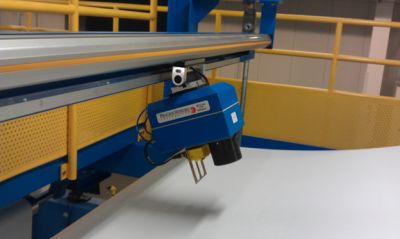NEAR INFRARED ON-LINE COAT-WEIGHT AND MOISTURE MEASUREMENT

PROCESS SENSORS MCT 360 NIR SENSOR MOUNTED IN A FIXED POSITION OR ON A SCANNING FRAME WILL PROVIDE INSTANTANEOUS MOISTURE, COAT-WEIGHT AND FILM THICKNESS MEASUREMENT ENABLING TIGHTER PROCESS CONTROL AND MORE PROFITABLE PRODUCTION.
Use of an on-line, as opposed to off-line measurement approach will rapidly improve process efficiency through quicker start-ups, lower generation of scrap and usage of coating material, and higher yields. The end product will be of a consistent high quality.
NIR technology lends itself to moisture and coat weight measurement as it is non-contact, instantaneous, cost effective, and inherently safe. This article outlines how NIR can be employed to make various measurements, the principle of the measurement and some typical applications and introduces the Guardian cross direction web profile system, Process Sensor’s scanner system.
NIR offers multiple approaches to solving a measurement problem:
Inorganic coatings such as titanium oxide and clay don’t absorb in the NIR but if they are applied in an aqueous carrier, measurement is feasible at the wet end of the process provided the solids ratio is constant or known.
Organic coat-weight applied to organic substrate can be determined by:
1. Measuring moisture if it’s an aqueous coating
2. Careful selection of absorption filters that are unique to the coating material
3. Use of a differential measurement if the substrate is flat, i.e. the substrate doesn’t vary significantly
in its thickness. This requires two sensors; one to measure pre- and one to measure post- coating
machine.
Coatings applied to a metallic substrate use diffuse optics, this enables measurement which would otherwise be impossible owing to surface reflections from the metal. Coatings applied to a transparent film can be measured through augmenting the signal by installing a passive reflector immediately behind the film.
In most instances, the application of a coating at either the wet or dry end of a process will result in a glossy surface which introduces surface reflections making the gauge noisier. Angling the gauge will optimise the signal: noise.
Coatings applied to narrow tapes can be measured by reducing the area of the measurement spot.
The Measurement principle:
NIR utilises the fact that molecular bonds such as O-H in water and C-H and N-H in organic coatings and films absorb NIR light in discrete wavelength regions in proportion to their concentration. The absorption is quantified by comparison of the signal at the measurement wavelength with the signal obtained at one or more reference wavelengths where there are no unique absorptions.
Applications:
One or two static NIR gauges are ideal for some applications owing to narrow web width or inability to make fine localised adjustments to the coating process, but in many instances mounting the sensor on an automatic scanner will provide a clearer picture of how evenly the coating is applied, and will enable corrective action to be taken, avoiding wastage of raw material, utilities and time through breaks in production.
The Guardian cross direction web profile system finds many applications within the Converting and Packaging Industry measuring moisture and coatings and film thickness on paper, film, foil, metal, textiles, and board products. A few applications are listed below:
Steel and aluminium coil production
Conversion coatings
Food and Beverage
Resin coatings on aluminium can stock
Flexible packaging coatings and film thickness
Paper and Converting
Moisture in paper after steam or water spray remoisturiser
Film thickness and aqueous/ solvent based wet end and dry organic coatings
Tape and Label Stock adhesive, moisture and silicone measurements
The Guardian cross direction web profile system
This scanning system comprises an MCT360 Near Infrared (NIR) Transmitter mounted on an automatic industrial scanning frame with built-in position encoder, industrial PC and easy to operate software.
The industrial PC can be installed in one of three ways: within an operating console, on an arm bracket or wall-mounted. The software is designed to be easy to view and understand.
The system features alarms, alerts, and digital interface for archiving data. The Cross Direction Web Profile System zone and web widths, scanning speed, and product recipes are all selectable through operator setup. These recipes can also be selected through an Ethernet connection from a remote central operating station. Multiple measurements and web profiles can be displayed on a single large screen. Data is output for each zone and the web profile average. The system can also be set up for machine direction trends when a specific zone needs to be monitored.
Please contact us at: 01536 408066 http://processsensors.co.uk/products/MCTSFS.asp to discuss your application today.
View our NEW Guardian Cross Direction Web Profiling System Brochure by clicking through the link below.
http://www.processsensors.co.uk/products/MCTSFS%20Brochure.pdf

